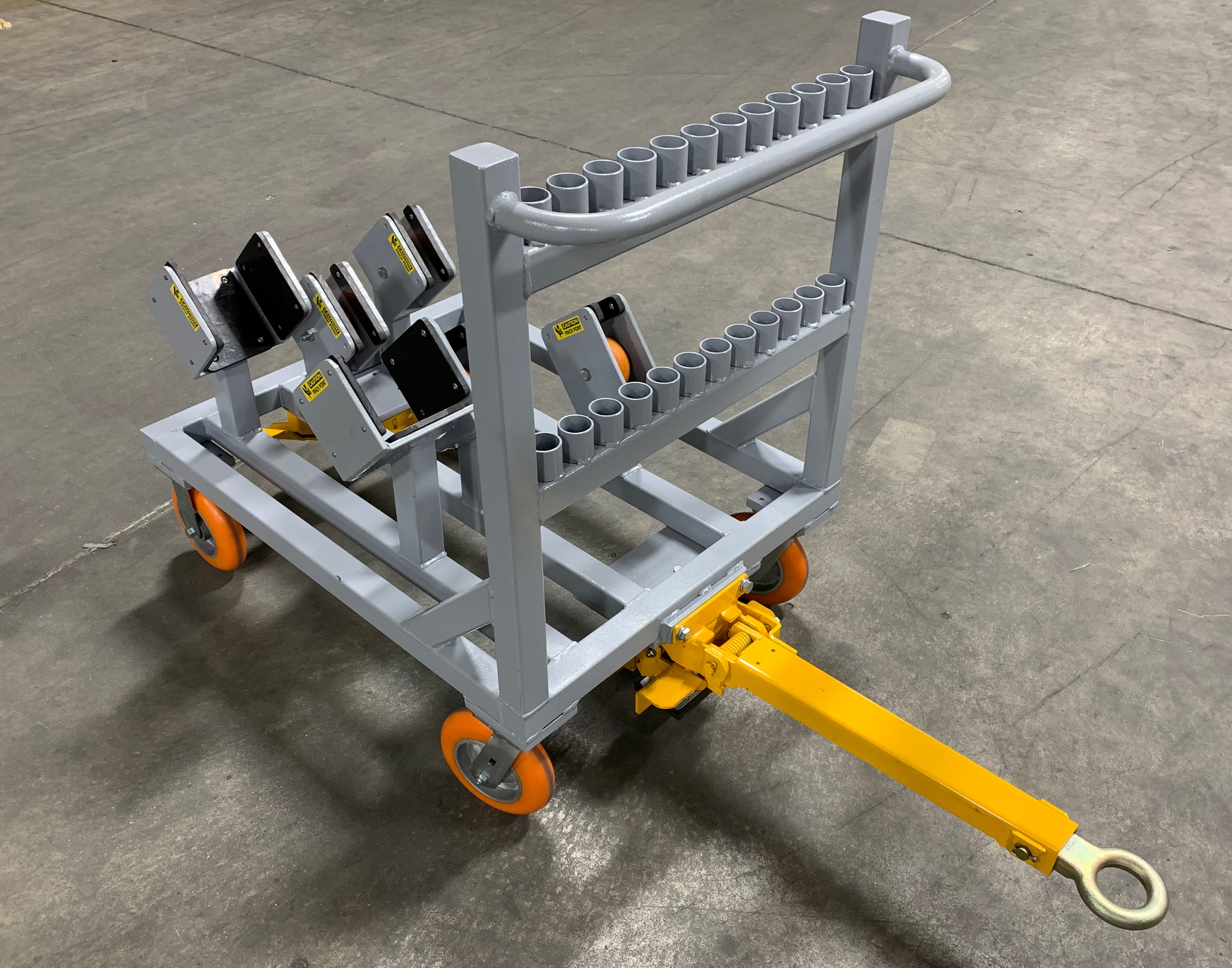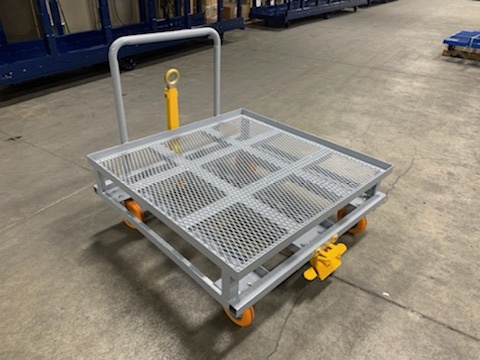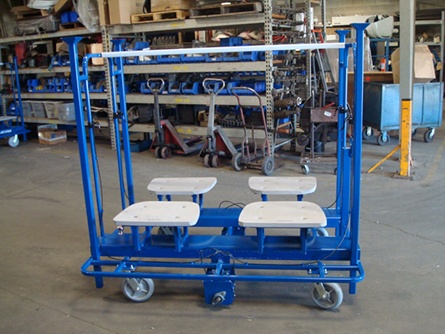5 Ways Work-In-Progress Carts Can Enhance Lean Manufacturing Practices
Have you ever watched a manufacturing floor operate like a well-oiled machine, with materials flowing seamlessly from one workstation to another? Behind this choreographed efficiency often lies an unsung hero: the work-in-progress cart. These mobile storage solutions have become indispensable tools for manufacturers looking to embrace lean principles and eliminate waste from their operations. At Plymouth Industries, we’ve seen firsthand how the right WIP cart can transform a chaotic production floor into a model of efficiency.
In the manufacturing landscape, every second counts, and every movement matters. That’s where work-in-process carts come into play, serving as the vital link between different stages of production. Think of them as the circulatory system of your manufacturing operation, keeping materials moving efficiently while preventing the buildup of excess inventory that can clog your production arteries.
Understanding Work In Progress Carts and Their Role in Lean Manufacturing
Work-in-progress carts are specialized mobile storage units designed to transport materials, components, and partially completed products between different stages of the manufacturing process. Unlike stationary storage solutions, these versatile tools bring flexibility and movement to your production floor. They’re not just simple trolleys — modern WIP carts are engineered solutions that can be customized with specific compartments, dividers, and features tailored to your unique production needs.
Picture a custom cart that’s perfectly sized for your components, with designated spaces for each part, clear labeling systems, and smooth-rolling casters that glide across your factory floor. That’s the essence of what makes these tools so valuable in lean manufacturing environments. They serve as mobile workstations, temporary storage solutions, and transportation vehicles all rolled into one efficient package.
The Connection Between WIP Carts and Lean Principles
Lean manufacturing revolves around eliminating waste and maximizing customer value. WIP carts directly support several core lean principles, including continuous flow, pull systems, and visual management. By providing a standardized method for moving work-in-progress inventory, these carts help create predictable, repeatable processes fundamental to lean success.
When you strategically implement WIP racks and carts throughout your facility, you create a physical manifestation of your value stream. Each cart becomes a visual indicator of production status, inventory levels, and workflow efficiency. This visibility is crucial for identifying bottlenecks, preventing overproduction, and maintaining the smooth flow of materials that lean manufacturing demands.

Way #1: Streamlining Material Flow and Reducing Transportation Waste
Creating Efficient Point-to-Point Material Movement
Transportation waste is one of the seven deadly wastes in lean manufacturing, and work-in-process carts are your secret weapon against it. Instead of workers making multiple trips carrying individual components, a well-designed WIP cart consolidates materials into organized, mobile units that can be moved efficiently between workstations. This consolidation alone can reduce material handling time by 40-60% in most manufacturing environments.
Consider how much time your workers spend walking back and forth, searching for materials, or waiting for forklifts to move heavy items. With strategically placed WIP carts, you create a smooth flow where materials arrive exactly when and where needed. It’s like having a personal delivery service for each workstation, ensuring that production never stops due to missing components or delayed material transfers.
Implementing Visual Management Systems
Visual management is a cornerstone of lean manufacturing, and work-in-progress carts serve as mobile billboards for your production status. By incorporating color-coding systems, clear labeling, and even digital displays, these carts communicate vital information at a glance. Red tags might indicate priority orders, while green sections show completed items ready for the next process.
The beauty of visual management through WIP carts lies in its simplicity. Anyone walking through your facility can immediately understand production status without checking computer systems or asking supervisors. This transparency creates accountability, speeds up decision-making, and helps identify problems before they escalate into production delays.
Way #2: Enhancing Organization Through Standardized Storage Solutions
Designing Custom Cart Configurations for Specific Workflows
Every manufacturing process is unique, so custom cart solutions are valuable. Rather than forcing your workflow to adapt to generic storage solutions, you can design WIP carts that perfectly match your production needs. Need compartments for delicate electronic components? No problem. Require hanging systems for fabricated parts? That’s easily incorporated into your cart design.
Understanding your specific workflow requirements is the key to effective organization through work-in-progress carts. Start by mapping out your production process, identifying the types and quantities of materials that move between stations. Then, design cart configurations that accommodate these materials while maintaining easy access and visibility. This customization ensures that every movement adds value rather than creating additional handling or searching time.
Establishing Clear Labeling and Identification Systems
Organization without identification is like having a library without a catalog system — technically organized but practically useless. Your WIP carts should feature clear, durable labeling systems that identify not just what’s stored but also where it’s going and when it’s needed. QR codes, RFID tags, or simple laminated labels can transform a basic cart into an intelligent storage system.
Implementing a standardized labeling system across all your WIP racks and carts creates a universal language on your production floor. Workers can quickly identify the right materials, verify destinations, and track inventory levels without confusion or delays. This standardization reduces errors, prevents mix-ups, and ensures that your lean manufacturing system operates with precision.

Way #3: Reducing Work In Progress Inventory and Cycle Times
Supporting Just-In-Time Manufacturing
Just-In-Time (JIT) manufacturing demands precise control over work in progress inventory, and that’s where WIP carts truly shine. By limiting the physical space available for materials, these carts naturally enforce inventory limits that prevent overproduction. It’s a simple but powerful concept: if you can only fit 50 units on a cart, you can’t accidentally produce 100 and create excess inventory.
The mobility of work in process carts also supports JIT by enabling quick changeovers and flexible production scheduling. When customer demands shift, you can easily reconfigure your cart fleet to support new production priorities. This agility is essential in today’s market, where customer expectations for variety and customization continue to grow while lead time expectations shrink.
Minimizing Buffer Stock Between Processes
Traditional manufacturing often relies on large buffer stocks between processes to ensure continuous production. However, these buffers tie up capital, consume valuable floor space, and can hide quality problems. WIP carts offer a better solution by providing controlled, mobile buffer zones that can be adjusted based on actual production needs rather than worst-case scenarios.
Using WIP carts as your buffer management system, you gain visibility into inventory levels and can make data-driven decisions about optimal buffer sizes. This approach reduces work-in-progress inventory by 30-50% while improving production reliability. It’s counterintuitive but true: less inventory often leads to smoother production flow when managed properly.
Way #4: Improving Workplace Safety and Ergonomics
Reducing Manual Handling Risks
Manufacturing environments present numerous safety challenges, and manual material handling is consistently one of the top causes of workplace injuries. Work-in-progress carts directly address this risk by providing ergonomic solutions for moving materials. Instead of workers lifting and carrying heavy components, they can push or pull a well-designed cart that distributes weight evenly and rolls smoothly.
Modern WIP carts incorporate ergonomic features like adjustable height platforms, push handles at optimal positions, and brake systems that prevent unwanted movement. These design elements reduce strain on workers’ backs, shoulders, and joints, leading to fewer injuries and improved productivity. Workers can focus on value-adding activities rather than managing pain or fatigue when they feel physically comfortable.
Creating Safer Work Environments
Beyond individual ergonomics, work-in-progress carts contribute to overall workplace safety by organizing materials and keeping walkways clear. Fixed storage locations often lead to materials spilling into aisles or creating obstacles, but mobile carts can be positioned exactly where needed without creating permanent obstructions. This flexibility is particularly valuable in facilities where space is at a premium.
Safety features on modern WIP carts go beyond basic functionality. Anti-tip designs prevent carts from overturning even when fully loaded, while corner bumpers protect the cart and surrounding equipment from collision damage. Some carts even include emergency stop features or automated guidance systems that enhance safety in busy production environments.

Way #5: Facilitating Continuous Improvement and Flexibility
Adapting to Changing Production Needs
One of the most valuable aspects of WIP carts in lean manufacturing is their inherent flexibility. Unlike fixed conveyor systems or permanent storage installations, carts can be reconfigured, repurposed, or relocated as production needs evolve. This adaptability is crucial for continuous improvement initiatives, where you constantly test new layouts and workflows to optimize efficiency.
When you invest in quality custom cart solutions, you’re solving today’s problems and creating a platform for future improvements. Your cart fleet can adapt as your product mix changes or new technologies emerge. This flexibility protects your investment while ensuring your lean manufacturing system remains agile and responsive to market demands.
Supporting Kaizen Initiatives
Kaizen, the practice of continuous improvement, thrives on experimentation and rapid implementation of improvements. WIP carts support this philosophy by enabling quick, low-risk changes to production flow. Want to test a new workstation layout? Simply roll the carts into new positions. Thinking about combining two processes? Use carts to create a temporary work cell and measure the results.
The modular nature of work-in-progress cart systems also encourages employee involvement in improvement initiatives. Workers can suggest cart modifications or new configurations based on their daily experiences, and these ideas can be implemented quickly without major capital investments. This participatory approach to improvement is essential for building a true culture of continuous improvement.
Choosing the Right WIP Cart Solution for Your Facility
Key Features to Consider
Selecting the right WIP cart for your facility requires careful consideration of several key features. First, evaluate the load capacity requirements based on your heaviest materials and components. Next, consider the mobility features — do you need carts that can navigate tight spaces, travel over uneven surfaces, or interface with automated systems? The caster selection alone can distinguish between smooth operation and constant frustration.
Durability is another critical factor when choosing WIP racks and carts. Industrial environments can be harsh, with exposure to chemicals, temperature variations, and constant use. Look for carts constructed from appropriate materials — powder-coated steel for general use, stainless steel for food production, or specialized plastics for chemical resistance. The initial investment in quality construction pays dividends through years of reliable service.
Customization Options and Benefits
The true power of custom cart solutions lies in their ability to match your exact specifications. From basic dimensional adjustments to complex integrated systems, customization ensures that your carts enhance rather than constrain your production processes. Consider features like adjustable shelving, modular compartments, integrated power supplies for mobile workstations, or specialized holders for unique components.
Working with experienced manufacturers like Plymouth Industries ensures that your customization efforts result in practical, durable solutions. Professional designers can help you balance functionality with cost, suggesting innovative features you might not have considered while keeping the overall design manufacturable and maintainable. This collaborative approach to customization delivers carts that truly serve as competitive advantages in your lean manufacturing journey.
Conclusion
The journey toward lean manufacturing excellence requires the right tools, and work-in-progress carts have proven themselves as indispensable assets in this transformation. From streamlining material flow and reducing waste to improving safety and supporting continuous improvement, these mobile solutions address multiple challenges with elegant simplicity. The five ways we’ve explored — enhancing material flow, improving organization, reducing inventory, increasing safety, and facilitating flexibility — demonstrate how WIP carts catalyze lean success.
As you evaluate your own manufacturing operations, consider how strategically implemented work-in-process carts could eliminate bottlenecks, reduce waste, and create a more efficient production environment. Investing in quality WIP cart solutions pays for itself through reduced labor costs, decreased inventory holding costs, improved quality, and enhanced worker satisfaction. Whether you’re just beginning your lean journey or looking to optimize an established system, the right cart solution can accelerate your progress toward operational excellence.
Frequently Asked Questions
Q1: How do I determine the optimal number of WIP carts for my facility?
The optimal number of WIP carts depends on several factors, including your production volume, the number of workstations, material flow patterns, and changeover frequencies. Analyze your value stream map to identify material transfer points and volumes. A general rule of thumb is to have enough carts to maintain continuous flow without creating excess inventory. Many facilities find success starting with one cart per workstation plus 20-30% additional carts for flexibility, then adjusting based on actual usage patterns.
Q2: What’s the difference between standard and custom WIP carts?
Standard WIP carts offer pre-designed configurations that work well for common applications, providing a cost-effective solution for typical material handling needs. On the other hand, custom cart solutions are designed specifically for your unique requirements, incorporating specialized features, dimensions, and accessories that match your workflow. While custom carts require a higher initial investment, they often deliver superior ROI through improved efficiency and reduced handling time.
Q3: How often should WIP carts be maintained or replaced?
Proper maintenance ensures quality work-in-progress carts can last 10-15 years or more in typical manufacturing environments. Establish a preventive maintenance schedule that includes monthly inspections of casters, bearings, and structural components. Lubricate moving parts quarterly, and address any damage immediately to prevent further deterioration. Replace casters when they show significant wear, as smooth mobility is essential for cart effectiveness. Consider replacement when repair costs exceed 50% of the new cart cost or when production needs have changed significantly.
Q4: Can WIP carts be integrated with automated systems?
Modern WIP carts can be integrated with various automated systems, including AGVs (Automated Guided Vehicles), RFID tracking systems, and automated storage and retrieval systems. Integration options range from simple RFID tags for tracking to fully automated carts that navigate independently. When planning integration, consider your current automation level, future expansion plans, and the ROI of different automation options. Start with simple tracking systems and evolve toward more complex automation as your needs and capabilities grow.
Q5: What safety regulations apply to WIP carts in manufacturing?
Work-in-process carts must comply with various safety regulations, including OSHA guidelines for material handling equipment, load capacity marking requirements, and workplace ergonomics standards. Key compliance areas include proper load rating labels, stable design to prevent tipping, appropriate caster selection for floor conditions, and ergonomic handle placement. Additionally, industry-specific requirements such as FDA regulations for food and pharmaceutical applications or ESD protection for electronics manufacturing should be considered. Always consult with safety professionals and regulatory experts when designing or selecting carts for your specific application.




